coolant JEEP COMPASS 2019 Owner handbook (in English)
[x] Cancel search | Manufacturer: JEEP, Model Year: 2019, Model line: COMPASS, Model: JEEP COMPASS 2019Pages: 362, PDF Size: 6.23 MB
Page 242 of 362

ENGINE COMPARTMENT
1.4L Engine
1 — Brake Fluid Reservoir 6 — Washer Fluid Reservoir
2 — Engine Oil Dipstick 7 — Coolant Pressure Cap
3 — Engine Oil Fill Cap 8 — Coolant Pressure Bottle
4 — Battery 9 — Engine Air Cleaner Filter
5 — Power Distribution Center (Fuses)
SERVICING AND MAINTENANCE
240
Page 243 of 362
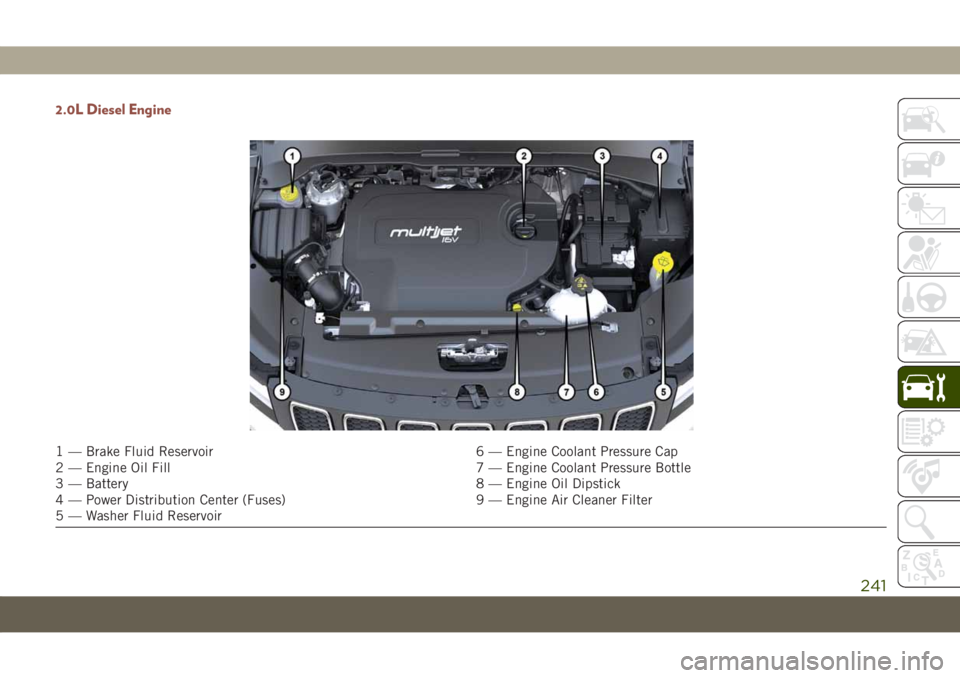
2.0L Diesel Engine
1 — Brake Fluid Reservoir 6 — Engine Coolant Pressure Cap
2 — Engine Oil Fill 7 — Engine Coolant Pressure Bottle
3 — Battery 8 — Engine Oil Dipstick
4 — Power Distribution Center (Fuses) 9 — Engine Air Cleaner Filter
5 — Washer Fluid Reservoir
241
Page 244 of 362
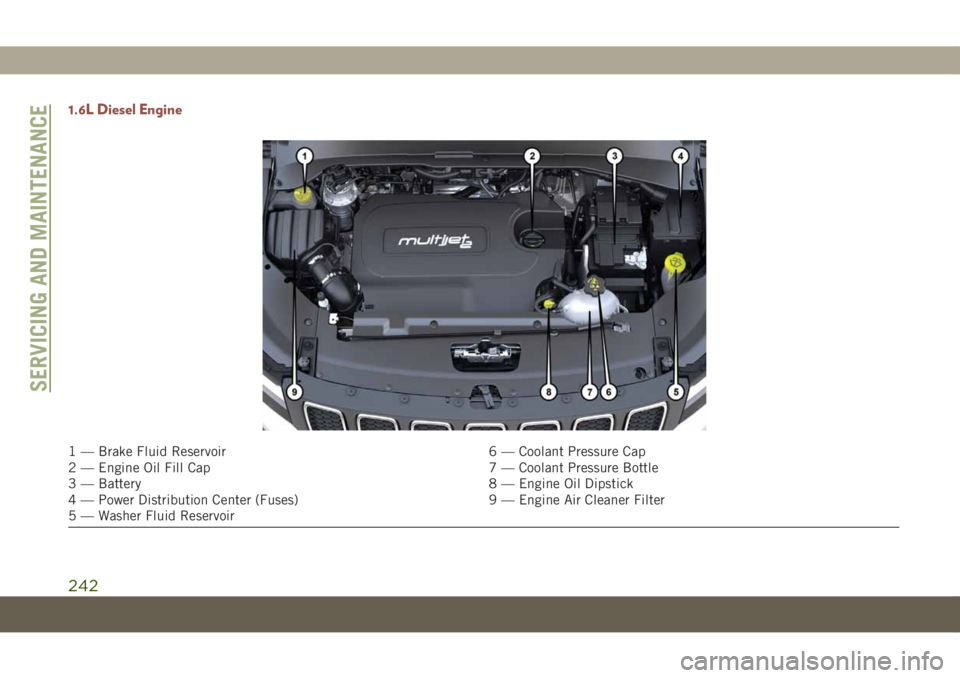
1.6L Diesel Engine
1 — Brake Fluid Reservoir 6 — Coolant Pressure Cap
2 — Engine Oil Fill Cap 7 — Coolant Pressure Bottle
3 — Battery 8 — Engine Oil Dipstick
4 — Power Distribution Center (Fuses) 9 — Engine Air Cleaner Filter
5 — Washer Fluid Reservoir
SERVICING AND MAINTENANCE
242
Page 249 of 362
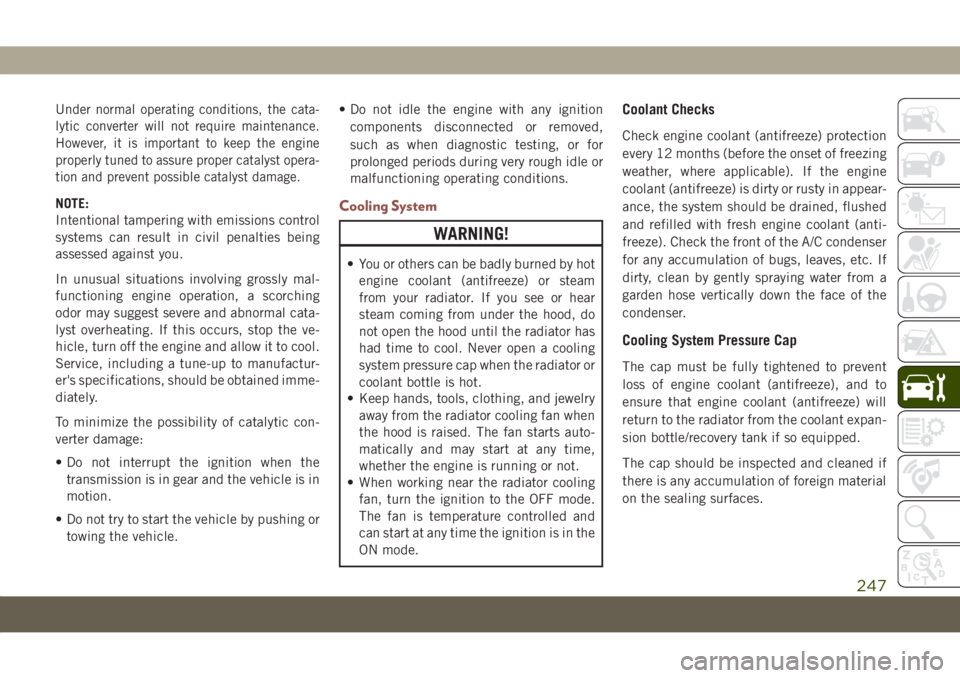
Under normal operating conditions, the cata-
lytic converter will not require maintenance.
However, it is important to keep the engine
properly tuned to assure proper catalyst opera-
tion and prevent possible catalyst damage.
NOTE:
Intentional tampering with emissions control
systems can result in civil penalties being
assessed against you.
In unusual situations involving grossly mal-
functioning engine operation, a scorching
odor may suggest severe and abnormal cata-
lyst overheating. If this occurs, stop the ve-
hicle, turn off the engine and allow it to cool.
Service, including a tune-up to manufactur-
er's specifications, should be obtained imme-
diately.
To minimize the possibility of catalytic con-
verter damage:
• Do not interrupt the ignition when the
transmission is in gear and the vehicle is in
motion.
• Do not try to start the vehicle by pushing or
towing the vehicle.• Do not idle the engine with any ignition
components disconnected or removed,
such as when diagnostic testing, or for
prolonged periods during very rough idle or
malfunctioning operating conditions.Cooling System
WARNING!
• You or others can be badly burned by hot
engine coolant (antifreeze) or steam
from your radiator. If you see or hear
steam coming from under the hood, do
not open the hood until the radiator has
had time to cool. Never open a cooling
system pressure cap when the radiator or
coolant bottle is hot.
• Keep hands, tools, clothing, and jewelry
away from the radiator cooling fan when
the hood is raised. The fan starts auto-
matically and may start at any time,
whether the engine is running or not.
• When working near the radiator cooling
fan, turn the ignition to the OFF mode.
The fan is temperature controlled and
can start at any time the ignition is in the
ON mode.
Coolant Checks
Check engine coolant (antifreeze) protection
every 12 months (before the onset of freezing
weather, where applicable). If the engine
coolant (antifreeze) is dirty or rusty in appear-
ance, the system should be drained, flushed
and refilled with fresh engine coolant (anti-
freeze). Check the front of the A/C condenser
for any accumulation of bugs, leaves, etc. If
dirty, clean by gently spraying water from a
garden hose vertically down the face of the
condenser.
Cooling System Pressure Cap
The cap must be fully tightened to prevent
loss of engine coolant (antifreeze), and to
ensure that engine coolant (antifreeze) will
return to the radiator from the coolant expan-
sion bottle/recovery tank if so equipped.
The cap should be inspected and cleaned if
there is any accumulation of foreign material
on the sealing surfaces.
247
Page 250 of 362
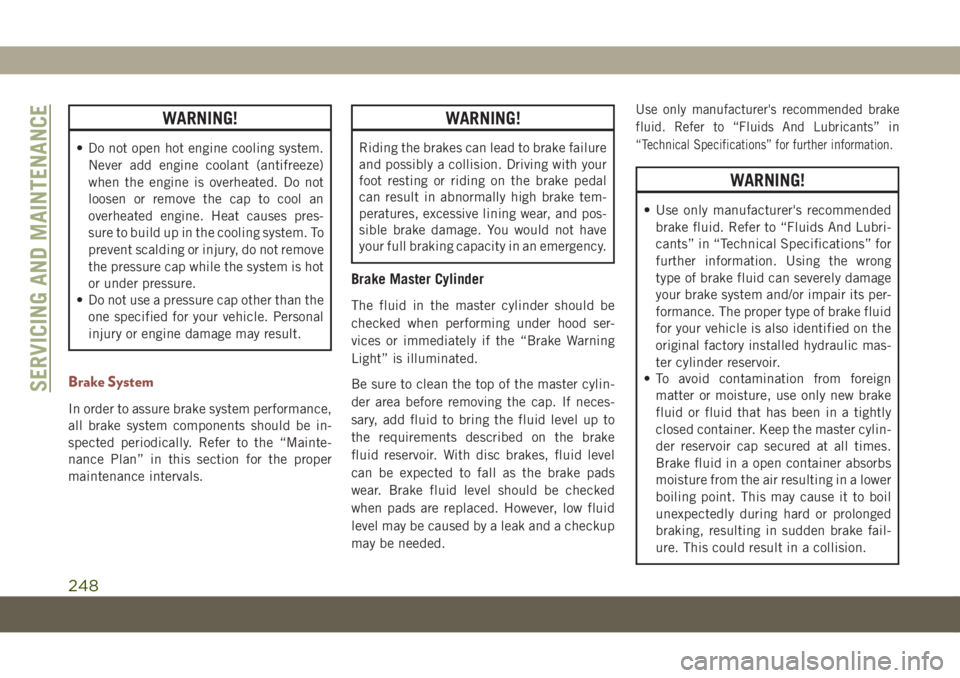
WARNING!
• Do not open hot engine cooling system.
Never add engine coolant (antifreeze)
when the engine is overheated. Do not
loosen or remove the cap to cool an
overheated engine. Heat causes pres-
sure to build up in the cooling system. To
prevent scalding or injury, do not remove
the pressure cap while the system is hot
or under pressure.
• Do not use a pressure cap other than the
one specified for your vehicle. Personal
injury or engine damage may result.
Brake System
In order to assure brake system performance,
all brake system components should be in-
spected periodically. Refer to the “Mainte-
nance Plan” in this section for the proper
maintenance intervals.
WARNING!
Riding the brakes can lead to brake failure
and possibly a collision. Driving with your
foot resting or riding on the brake pedal
can result in abnormally high brake tem-
peratures, excessive lining wear, and pos-
sible brake damage. You would not have
your full braking capacity in an emergency.
Brake Master Cylinder
The fluid in the master cylinder should be
checked when performing under hood ser-
vices or immediately if the “Brake Warning
Light” is illuminated.
Be sure to clean the top of the master cylin-
der area before removing the cap. If neces-
sary, add fluid to bring the fluid level up to
the requirements described on the brake
fluid reservoir. With disc brakes, fluid level
can be expected to fall as the brake pads
wear. Brake fluid level should be checked
when pads are replaced. However, low fluid
level may be caused by a leak and a checkup
may be needed.
Use only manufacturer's recommended brake
fluid. Refer to “Fluids And Lubricants” in
“Technical Specifications” for further information.
WARNING!
• Use only manufacturer's recommended
brake fluid. Refer to “Fluids And Lubri-
cants” in “Technical Specifications” for
further information. Using the wrong
type of brake fluid can severely damage
your brake system and/or impair its per-
formance. The proper type of brake fluid
for your vehicle is also identified on the
original factory installed hydraulic mas-
ter cylinder reservoir.
• To avoid contamination from foreign
matter or moisture, use only new brake
fluid or fluid that has been in a tightly
closed container. Keep the master cylin-
der reservoir cap secured at all times.
Brake fluid in a open container absorbs
moisture from the air resulting in a lower
boiling point. This may cause it to boil
unexpectedly during hard or prolonged
braking, resulting in sudden brake fail-
ure. This could result in a collision.
SERVICING AND MAINTENANCE
248
Page 277 of 362
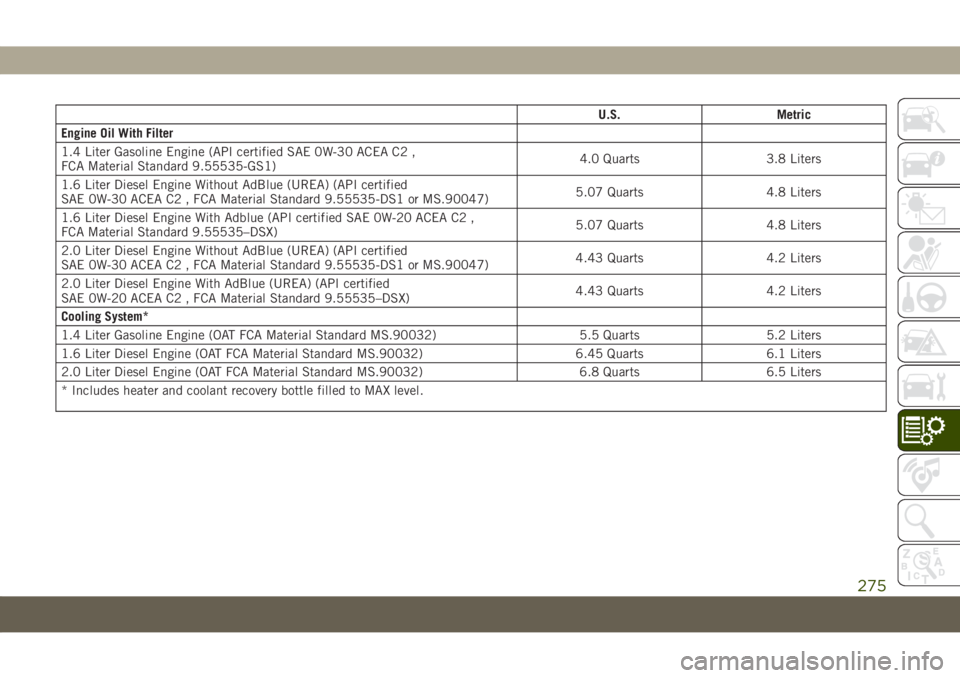
U.S. Metric
Engine Oil With Filter
1.4 Liter Gasoline Engine (API certified SAE 0W-30 ACEA C2 ,
FCA Material Standard 9.55535-GS1)4.0 Quarts 3.8 Liters
1.6 Liter Diesel Engine Without AdBlue (UREA) (API certified
SAE 0W-30 ACEA C2 , FCA Material Standard 9.55535-DS1 or MS.90047)5.07 Quarts 4.8 Liters
1.6 Liter Diesel Engine With Adblue (API certified SAE 0W-20 ACEA C2 ,
FCA Material Standard 9.55535–DSX)5.07 Quarts 4.8 Liters
2.0 Liter Diesel Engine Without AdBlue (UREA) (API certified
SAE 0W-30 ACEA C2 , FCA Material Standard 9.55535-DS1 or MS.90047)4.43 Quarts 4.2 Liters
2.0 Liter Diesel Engine With AdBlue (UREA) (API certified
SAE 0W-20 ACEA C2 , FCA Material Standard 9.55535–DSX)4.43 Quarts 4.2 Liters
Cooling System*
1.4 Liter Gasoline Engine (OAT FCA Material Standard MS.90032) 5.5 Quarts 5.2 Liters
1.6 Liter Diesel Engine (OAT FCA Material Standard MS.90032) 6.45 Quarts 6.1 Liters
2.0 Liter Diesel Engine (OAT FCA Material Standard MS.90032) 6.8 Quarts 6.5 Liters
* Includes heater and coolant recovery bottle filled to MAX level.
275
Page 278 of 362
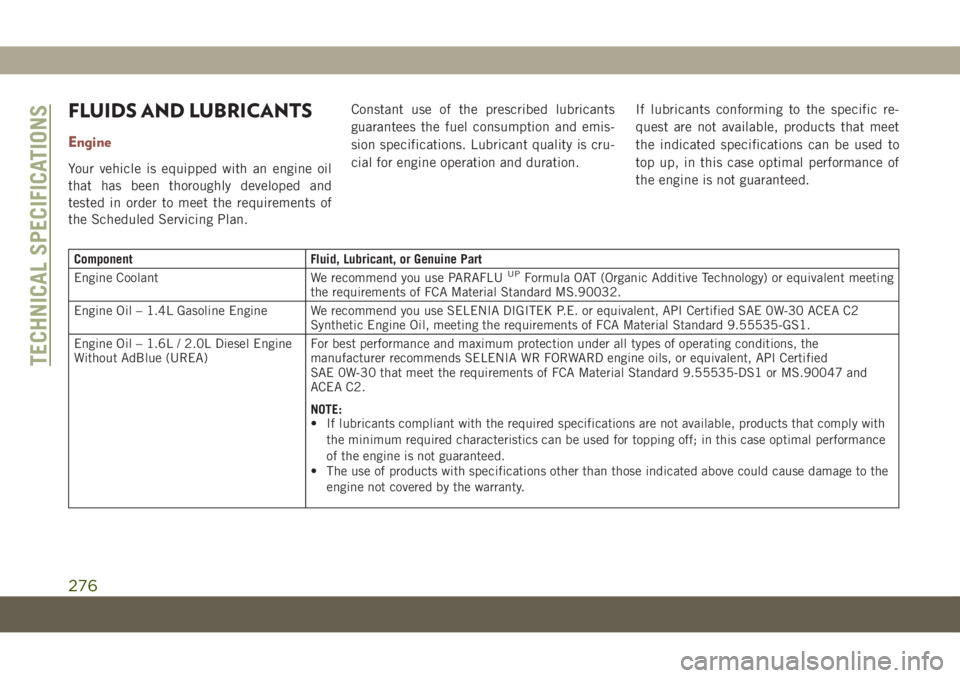
FLUIDS AND LUBRICANTS
Engine
Your vehicle is equipped with an engine oil
that has been thoroughly developed and
tested in order to meet the requirements of
the Scheduled Servicing Plan.Constant use of the prescribed lubricants
guarantees the fuel consumption and emis-
sion specifications. Lubricant quality is cru-
cial for engine operation and duration.If lubricants conforming to the specific re-
quest are not available, products that meet
the indicated specifications can be used to
top up, in this case optimal performance of
the engine is not guaranteed.
Component Fluid, Lubricant, or Genuine Part
Engine Coolant We recommend you use PARAFLUUPFormula OAT (Organic Additive Technology) or equivalent meeting
the requirements of FCA Material Standard MS.90032.
Engine Oil – 1.4L Gasoline Engine We recommend you use SELENIA DIGITEK P.E. or equivalent, API Certified SAE 0W-30 ACEA C2
Synthetic Engine Oil, meeting the requirements of FCA Material Standard 9.55535-GS1.
Engine Oil – 1.6L / 2.0L Diesel Engine
Without AdBlue (UREA)For best performance and maximum protection under all types of operating conditions, the
manufacturer recommends SELENIA WR FORWARD engine oils, or equivalent, API Certified
SAE 0W-30 that meet the requirements of FCA Material Standard 9.55535-DS1 or MS.90047 and
ACEA C2.
NOTE:
• If lubricants compliant with the required specifications are not available, products that comply with
the minimum required characteristics can be used for topping off; in this case optimal performance
of the engine is not guaranteed.
• The use of products with specifications other than those indicated above could cause damage to the
engine not covered by the warranty.
TECHNICAL SPECIFICATIONS
276
Page 280 of 362
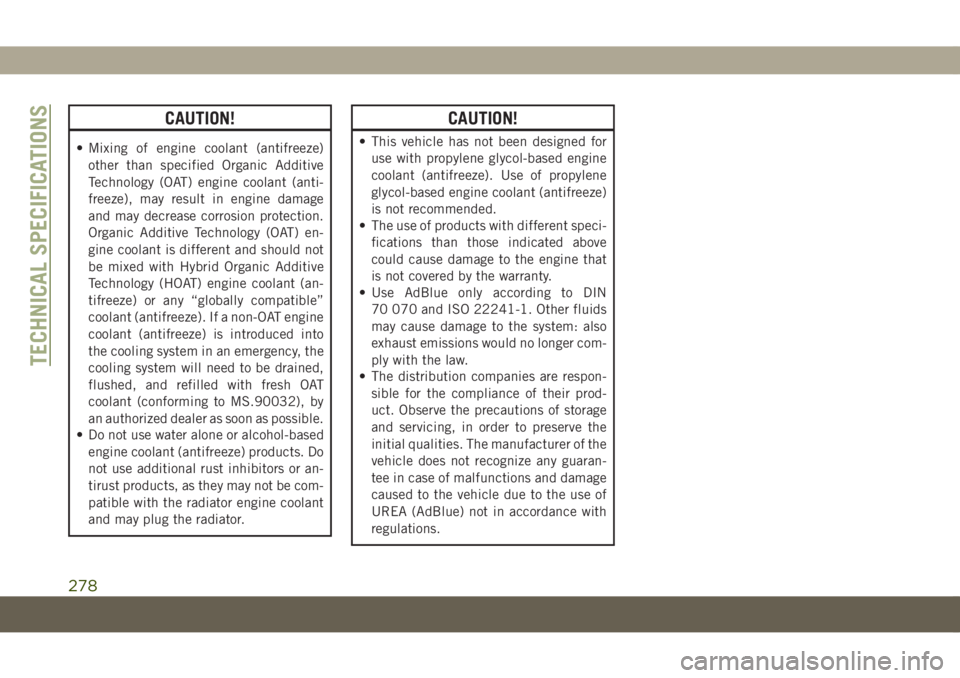
CAUTION!
• Mixing of engine coolant (antifreeze)
other than specified Organic Additive
Technology (OAT) engine coolant (anti-
freeze), may result in engine damage
and may decrease corrosion protection.
Organic Additive Technology (OAT) en-
gine coolant is different and should not
be mixed with Hybrid Organic Additive
Technology (HOAT) engine coolant (an-
tifreeze) or any “globally compatible”
coolant (antifreeze). If a non-OAT engine
coolant (antifreeze) is introduced into
the cooling system in an emergency, the
cooling system will need to be drained,
flushed, and refilled with fresh OAT
coolant (conforming to MS.90032), by
an authorized dealer as soon as possible.
• Do not use water alone or alcohol-based
engine coolant (antifreeze) products. Do
not use additional rust inhibitors or an-
tirust products, as they may not be com-
patible with the radiator engine coolant
and may plug the radiator.
CAUTION!
• This vehicle has not been designed for
use with propylene glycol-based engine
coolant (antifreeze). Use of propylene
glycol-based engine coolant (antifreeze)
is not recommended.
• The use of products with different speci-
fications than those indicated above
could cause damage to the engine that
is not covered by the warranty.
• Use AdBlue only according to DIN
70 070 and ISO 22241-1. Other fluids
may cause damage to the system: also
exhaust emissions would no longer com-
ply with the law.
• The distribution companies are respon-
sible for the compliance of their prod-
uct. Observe the precautions of storage
and servicing, in order to preserve the
initial qualities. The manufacturer of the
vehicle does not recognize any guaran-
tee in case of malfunctions and damage
caused to the vehicle due to the use of
UREA (AdBlue) not in accordance with
regulations.
TECHNICAL SPECIFICATIONS
278
Page 351 of 362
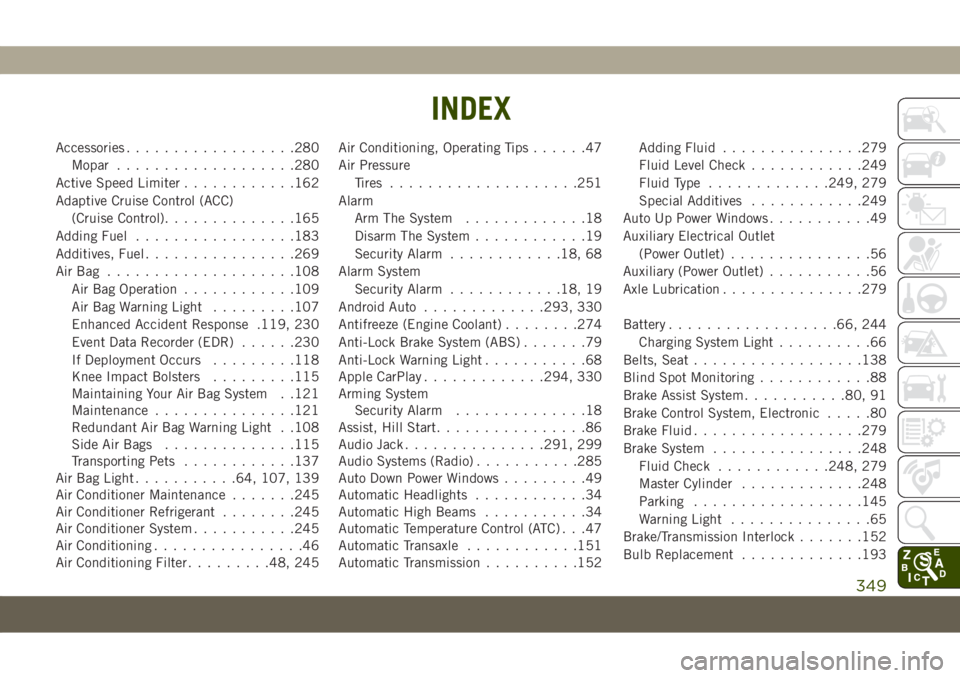
Accessories..................280
Mopar...................280
Active Speed Limiter............162
Adaptive Cruise Control (ACC)
(Cruise Control)..............165
Adding Fuel.................183
Additives, Fuel................269
AirBag ....................108
Air Bag Operation............109
Air Bag Warning Light.........107
Enhanced Accident Response .119, 230
Event Data Recorder (EDR)......230
If Deployment Occurs.........118
Knee Impact Bolsters.........115
Maintaining Your Air Bag System . .121
Maintenance...............121
Redundant Air Bag Warning Light . .108
Side Air Bags..............115
Transporting Pets............137
Air Bag Light...........64, 107, 139
Air Conditioner Maintenance.......245
Air Conditioner Refrigerant........245
Air Conditioner System...........245
Air Conditioning................46
Air Conditioning Filter.........48, 245Air Conditioning, Operating Tips......47
Air Pressure
Tires....................251
Alarm
Arm The System.............18
Disarm The System............19
Security Alarm............18, 68
Alarm System
Security Alarm............18, 19
Android Auto.............293, 330
Antifreeze (Engine Coolant)........274
Anti-Lock Brake System (ABS).......79
Anti-Lock Warning Light...........68
Apple CarPlay.............294, 330
Arming System
Security Alarm..............18
Assist, Hill Start................86
Audio Jack..............
.291, 299
Audio Systems (Radio)...........285
Auto Down Power Windows.........49
Automatic Headlights............34
Automatic High Beams...........34
Automatic Temperature Control (ATC) . . .47
Automatic Transaxle............151
Automatic Transmission..........152Adding Fluid...............279
Fluid Level Check............249
Fluid Type.............249, 279
Special Additives............249
Auto Up Power Windows...........49
Auxiliary Electrical Outlet
(Power Outlet)...............56
Auxiliary (Power Outlet)...........56
Axle Lubrication...............279
Battery..................66, 244
Charging System Light..........66
Belts, Seat..................138
Blind Spot Monitoring............88
Brake Assist System...........80, 91
Brake Control System, Electronic.....80
Brake Fluid..................279
Brake System................248
Fluid Check............248, 279
Master Cylinder.............248
Parking..................145
Warning Light...............65
Brake/Transmission Interlock.......152
Bulb Replacement.............193
INDEX
349
Page 352 of 362
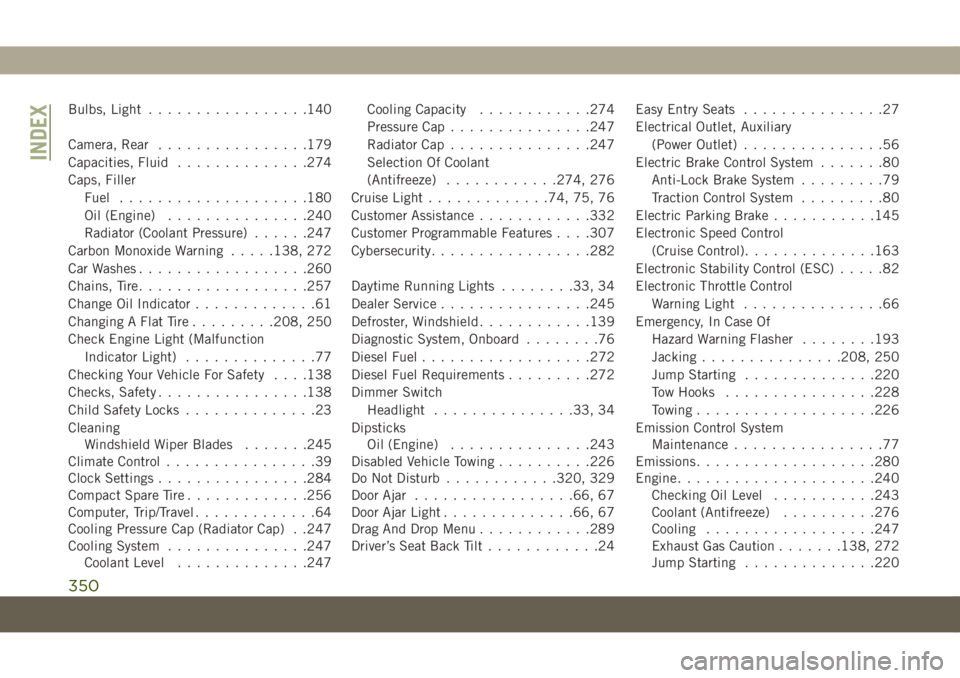
Bulbs, Light.................140
Camera, Rear................179
Capacities, Fluid..............274
Caps, Filler
Fuel....................180
Oil (Engine)...............240
Radiator (Coolant Pressure)......247
Carbon Monoxide Warning.....138, 272
Car Washes..................260
Chains, Tire..................257
Change Oil Indicator.............61
Changing A Flat Tire.........208, 250
Check Engine Light (Malfunction
Indicator Light)..............77
Checking Your Vehicle For Safety. . . .138
Checks, Safety................138
Child Safety Locks..............23
Cleaning
Windshield Wiper Blades.......245
Climate Control................39
Clock Settings................284
Compact Spare Tire.............256
Computer, Trip/Travel.............64
Cooling Pressure Cap (Radiator Cap) . .247
Cooling System...............247
Coolant Level..............247Cooling Capacity............274
Pressure Cap...............247
Radiator Cap...............247
Selection Of Coolant
(Antifreeze)............274, 276
Cruise Light.............74, 75, 76
Customer Assistance............332
Customer Programmable Features. . . .307
Cybersecurity.................282
Daytime Running Lights........33, 34
Dealer Service................245
Defroster, Windshield............139
Diagnostic System, Onboard........76
Diesel Fuel.................
.272
Diesel Fuel Requirements
.........272
Dimmer Switch
Headlight...............33, 34
Dipsticks
Oil (Engine)...............243
Disabled Vehicle Towing..........226
Do Not Disturb............320, 329
Door Ajar.................66, 67
Door Ajar Light..............66, 67
Drag And Drop Menu............289
Driver’s Seat Back Tilt............24Easy Entry Seats...............27
Electrical Outlet, Auxiliary
(Power Outlet)...............56
Electric Brake Control System.......80
Anti-Lock Brake System.........79
Traction Control System.........80
Electric Parking Brake...........145
Electronic Speed Control
(Cruise Control)..............163
Electronic Stability Control (ESC).....82
Electronic Throttle Control
Warning Light...............66
Emergency, In Case Of
Hazard Warning Flasher........193
Jacking...............208, 250
Jump Starting..............220
Tow Hooks................228
Towing...................226
Emission Control System
Maintenance................77
Emissions...................280
Engine.....................240
Checking Oil Level...........243
Coolant (Antifreeze)..........276
Cooling..................247
Exhaust Gas Caution.......138, 272
Jump Starting..............220
INDEX
350